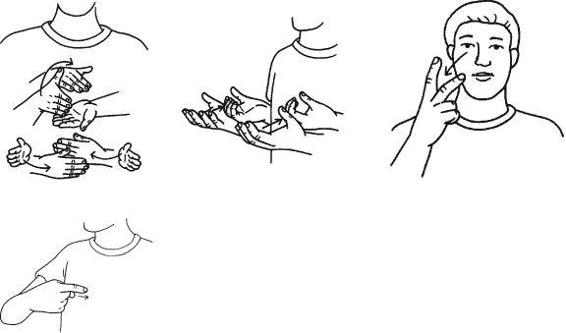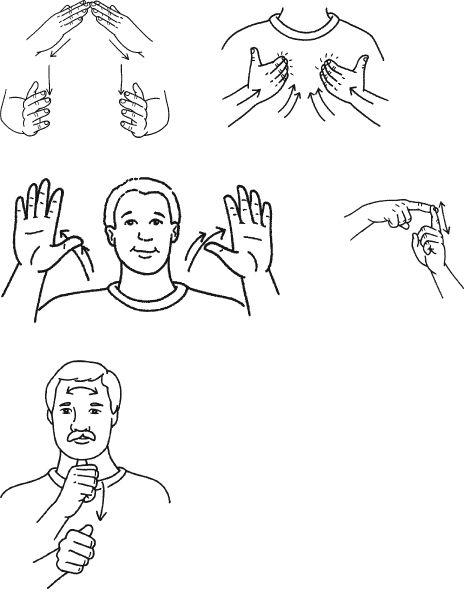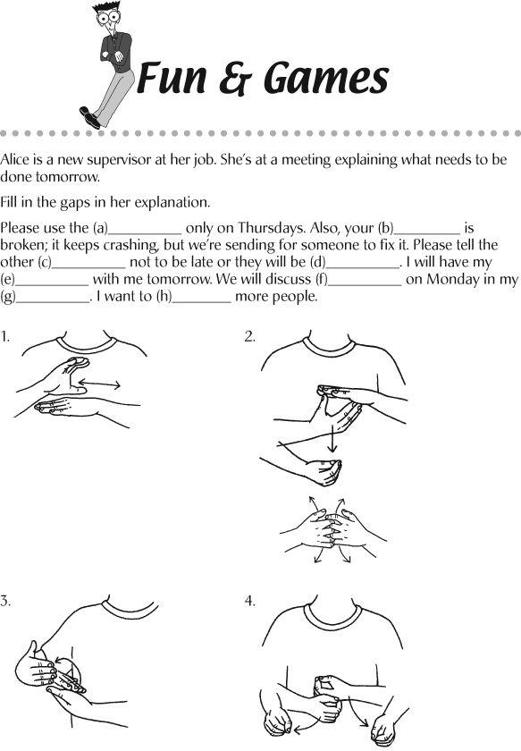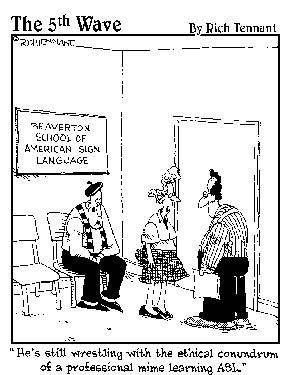Signing For Dummies (49 page)
Read Signing For Dummies Online
Authors: Adan R. Penilla,Angela Lee Taylor

Keeping Track of Your Subjects in Space
At work or at home, you’re always talking about people who aren’t right there with you. For instance, at work, you may be discussing with one of your co-workers how much you like your boss. When using Sign, you don’t have to be able to see someone (or something) to be able to talk about him, her, or it. (It’s a good thing, too. How else could you plan a surprise party for your spouse?)
All you have to do to discuss someone who isn’t physically present is assign that person a point in the space near your passive hand. You use the same Sign for
he, she,
and
it
— your index finger extended in a pointing gesture (see
Chapter 1
). If the he, she, or it is nearby, your index finger points at them, but if they’re not in your general vicinity, you select a specific place in the space in front of you to sort of “stand in” for the person you’re discussing. You point to that same space every time you refer to the absent one. So if you want to sign about Buddy, fingerspell his name and point to your passive hand area.
Signin’ the Sign
Dave and Debby have just purchased their first house. Here’s what they have to say about it.
Dave:
The house has a big yard.
Sign:
HOUSE YARD — BIG
Debbie:
I want to see the kitchen.
Sign:
KITCHEN — WANT SEE ME
Dave:
We need a couch, lamp, and pictures.
Sign:
COUCH LAMP PICTURES — NEED US
Debbie:
It’s great to own, not rent, a house.
Sign:
HOUSE — OWN GREAT — RENT NOT
Part III: Signing On the Go
In this part . . .
T
he chapters in this part add direction to your Signing. You find out how to sign landmarks and directions, so that you can tell a Deaf person how to get somewhere or find out how to get to a particular destination yourself. This part also gives you a glimpse of some medical terms and body parts that may be a big help in certain situations, not necessarily just the medical ones.
Chapter 10: Asking Directions and Getting Around
In This Chapter
Getting where you need to go can happen as quickly as a wave of your hand. You can go a long way by using these Signs for directions and transportation.
Finding Your Way
When giving or getting directions in Sign, you need to keep two things in mind. Get these strategies down, and you can tell people exactly where to go and how to get there:
• Try to start with a point of reference that’s familiar to both of you, such as a store, restaurant, or bridge, then give the directions.
• Go from big to small; from general to specific.
For example, in the States, you go from state to city to neighborhood to street to house number.
Table 10-1 groups Signs for compass points and other directional signals. Notice that the handshapes you use for the
compass points
and for
left
and
right
are the first letters of the words.
The following examples show you how to sign directions in perfect order.
English:
My house is west of the store.
Sign:
STORE — MY HOUSE WEST
English:
Turn right twice.
Sign:
RIGHT — RIGHT
Notice that you don’t use once, twice, and so on; you simply sign
right
two times (twice).
To give directions, you often establish relationships — don’t worry; you don’t have to commit for very long. Table 10-2 lists the Signs for the situational relationships you use to give directions as well as some landmarks and distances that you might use.
To sign straight, use the B manual handshape; rest it on your nose while your index finger touches your forehead and then move it straight out in front of you, bending your wrist.
This Sign is also the Sign for “sober” — the sentence’s context tells you which one. This same B handshape is used to sign the direction to turn onto a street.












